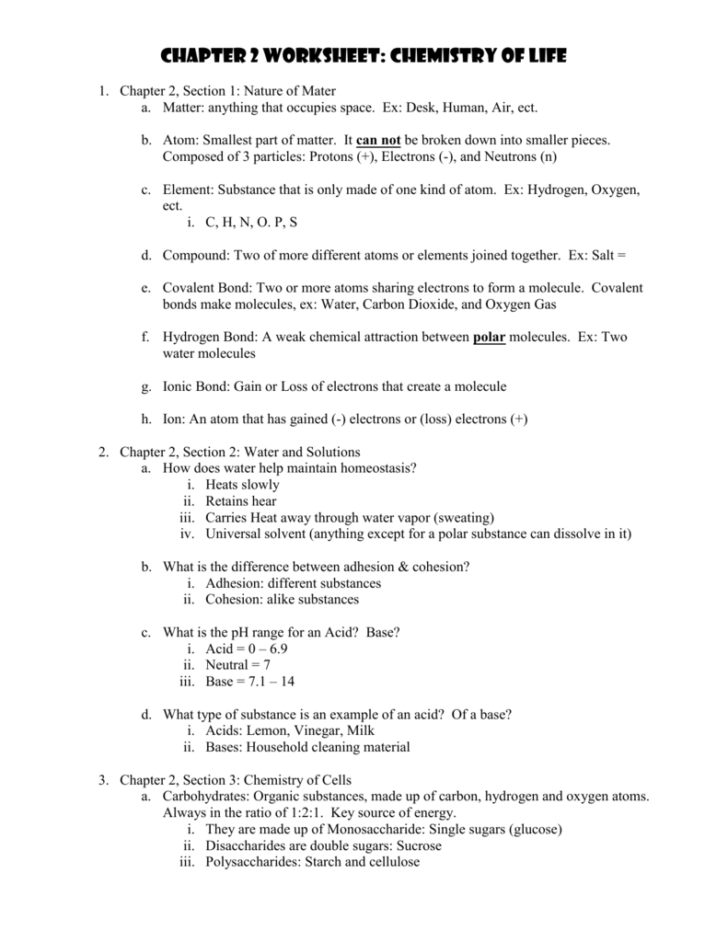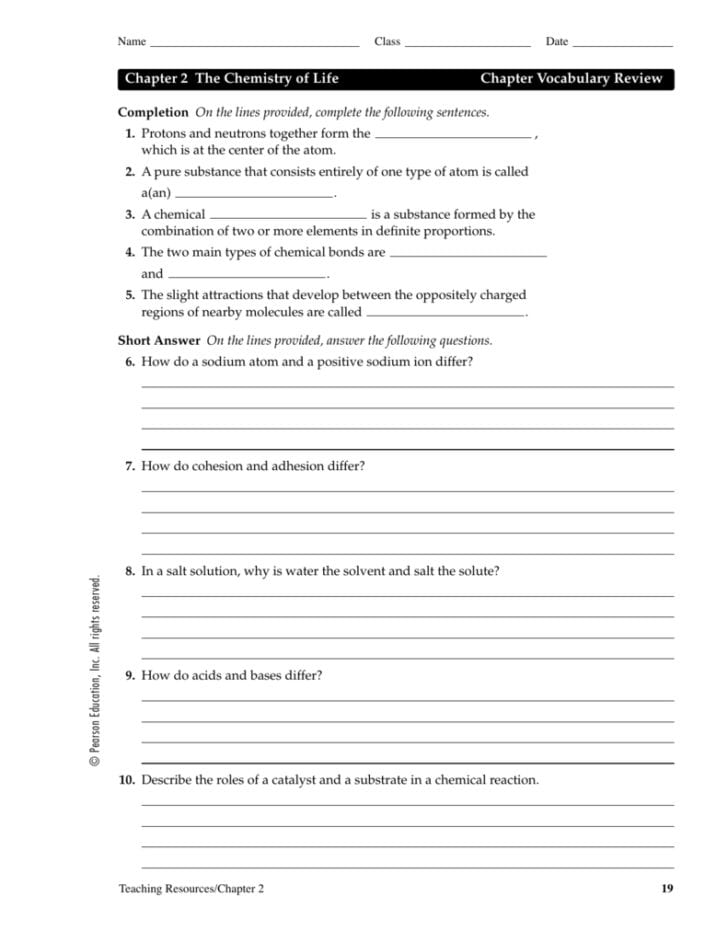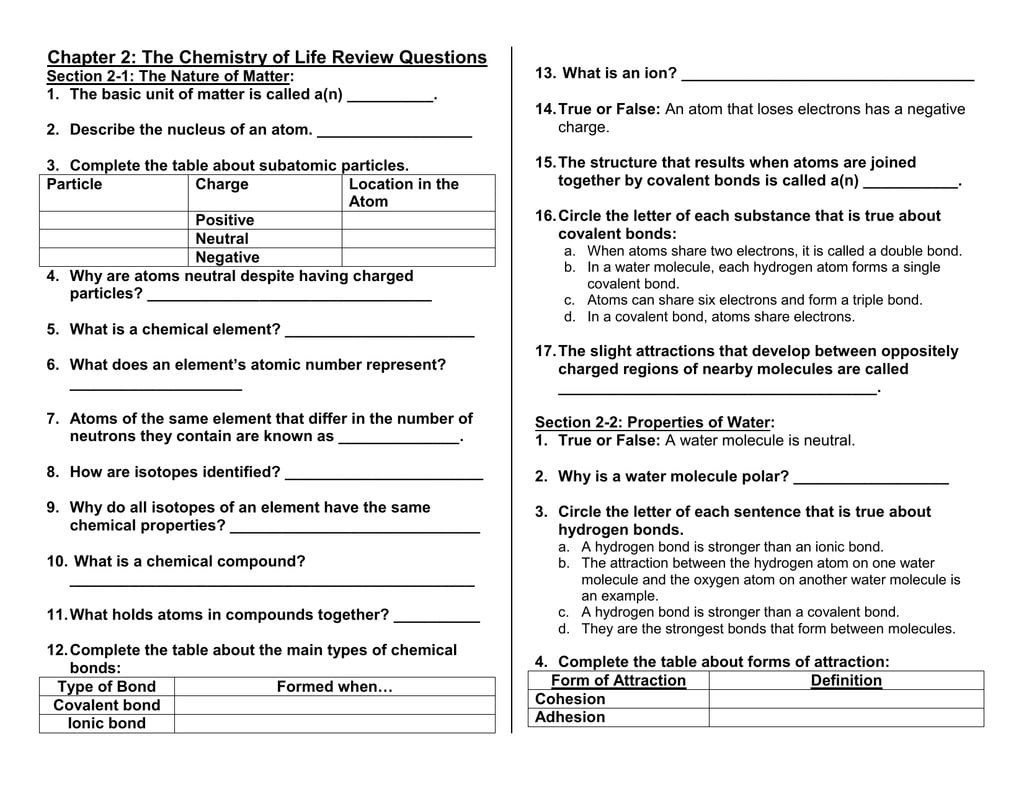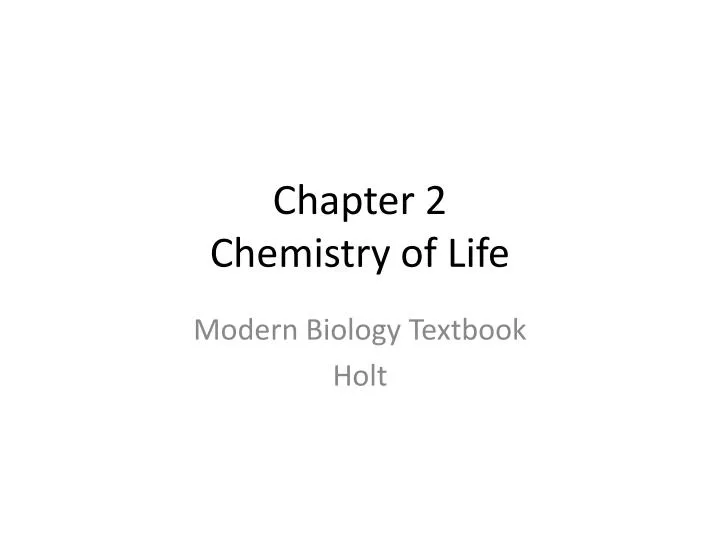Chapter 2 Chemistry Of Life
Chapter 2 Chemistry Of Life - To understand organisms, one must have a basic appreciation of the principles of chemistry… Figure 2.1 foods such as bread, fruit, and cheese are rich sources of biological macromolecules. 2.1 the building blocks of molecules. Web unit 1 intro to biology unit 2 chemistry of life unit 3 water, acids, and bases unit 4 properties of carbon unit 5 macromolecules unit 6 elements of life unit 7 energy and. Introduction to the chemistry of life. Click the card to flip 👆 the subatomic particles that make up atoms. Web key concepts living organisms are made from chemical compounds, and everything they do must obey all the laws of chemistry and physics. The elements carbon, hydrogen, nitrogen, oxygen, sulfur, and phosphorus.
Click the card to flip 👆 the subatomic particles that make up atoms. To understand organisms, one must have a basic appreciation of the principles of chemistry… Introduction to the chemistry of life. Figure 2.1 foods such as bread, fruit, and cheese are rich sources of biological macromolecules. The elements carbon, hydrogen, nitrogen, oxygen, sulfur, and phosphorus. 2.1 the building blocks of molecules. Web unit 1 intro to biology unit 2 chemistry of life unit 3 water, acids, and bases unit 4 properties of carbon unit 5 macromolecules unit 6 elements of life unit 7 energy and. Web key concepts living organisms are made from chemical compounds, and everything they do must obey all the laws of chemistry and physics.
Web key concepts living organisms are made from chemical compounds, and everything they do must obey all the laws of chemistry and physics. Click the card to flip 👆 the subatomic particles that make up atoms. The elements carbon, hydrogen, nitrogen, oxygen, sulfur, and phosphorus. Web unit 1 intro to biology unit 2 chemistry of life unit 3 water, acids, and bases unit 4 properties of carbon unit 5 macromolecules unit 6 elements of life unit 7 energy and. Introduction to the chemistry of life. 2.1 the building blocks of molecules. Figure 2.1 foods such as bread, fruit, and cheese are rich sources of biological macromolecules. To understand organisms, one must have a basic appreciation of the principles of chemistry…
Chapter 2 The Chemistry Of Life Worksheet Answers —
To understand organisms, one must have a basic appreciation of the principles of chemistry… 2.1 the building blocks of molecules. Web unit 1 intro to biology unit 2 chemistry of life unit 3 water, acids, and bases unit 4 properties of carbon unit 5 macromolecules unit 6 elements of life unit 7 energy and. Web key concepts living organisms are.
Biology Chapter 2 The Chemistry Of Life Worksheet Answers —
The elements carbon, hydrogen, nitrogen, oxygen, sulfur, and phosphorus. Click the card to flip 👆 the subatomic particles that make up atoms. Web unit 1 intro to biology unit 2 chemistry of life unit 3 water, acids, and bases unit 4 properties of carbon unit 5 macromolecules unit 6 elements of life unit 7 energy and. Figure 2.1 foods such.
Chapter 2 The Chemistry Of Life Review Questions —
To understand organisms, one must have a basic appreciation of the principles of chemistry… Web key concepts living organisms are made from chemical compounds, and everything they do must obey all the laws of chemistry and physics. Figure 2.1 foods such as bread, fruit, and cheese are rich sources of biological macromolecules. Introduction to the chemistry of life. The elements.
PPT Chapter 2 Chemistry of Life PowerPoint Presentation, free
Introduction to the chemistry of life. The elements carbon, hydrogen, nitrogen, oxygen, sulfur, and phosphorus. Click the card to flip 👆 the subatomic particles that make up atoms. Figure 2.1 foods such as bread, fruit, and cheese are rich sources of biological macromolecules. Web unit 1 intro to biology unit 2 chemistry of life unit 3 water, acids, and bases.
Biology Chapter 2 The Chemistry Of Life Worksheet Answers —
Web key concepts living organisms are made from chemical compounds, and everything they do must obey all the laws of chemistry and physics. Click the card to flip 👆 the subatomic particles that make up atoms. 2.1 the building blocks of molecules. Web unit 1 intro to biology unit 2 chemistry of life unit 3 water, acids, and bases unit.
PPT Chapter 2 Chemistry of Life PowerPoint Presentation, free
The elements carbon, hydrogen, nitrogen, oxygen, sulfur, and phosphorus. Web unit 1 intro to biology unit 2 chemistry of life unit 3 water, acids, and bases unit 4 properties of carbon unit 5 macromolecules unit 6 elements of life unit 7 energy and. 2.1 the building blocks of molecules. To understand organisms, one must have a basic appreciation of the.
chapter 2 The chemistry of life Crossword WordMint
Web unit 1 intro to biology unit 2 chemistry of life unit 3 water, acids, and bases unit 4 properties of carbon unit 5 macromolecules unit 6 elements of life unit 7 energy and. Web key concepts living organisms are made from chemical compounds, and everything they do must obey all the laws of chemistry and physics. Figure 2.1 foods.
chapter 2 The chemistry of life Crossword WordMint
Click the card to flip 👆 the subatomic particles that make up atoms. Web key concepts living organisms are made from chemical compounds, and everything they do must obey all the laws of chemistry and physics. Figure 2.1 foods such as bread, fruit, and cheese are rich sources of biological macromolecules. Introduction to the chemistry of life. Web unit 1.
PPT Chapter 2 Notes The Chemistry of Life PowerPoint Presentation
Web key concepts living organisms are made from chemical compounds, and everything they do must obey all the laws of chemistry and physics. Web unit 1 intro to biology unit 2 chemistry of life unit 3 water, acids, and bases unit 4 properties of carbon unit 5 macromolecules unit 6 elements of life unit 7 energy and. To understand organisms,.
Chapter 2 Chemistry of Life
2.1 the building blocks of molecules. Web key concepts living organisms are made from chemical compounds, and everything they do must obey all the laws of chemistry and physics. Introduction to the chemistry of life. Figure 2.1 foods such as bread, fruit, and cheese are rich sources of biological macromolecules. To understand organisms, one must have a basic appreciation of.
Web Key Concepts Living Organisms Are Made From Chemical Compounds, And Everything They Do Must Obey All The Laws Of Chemistry And Physics.
Introduction to the chemistry of life. To understand organisms, one must have a basic appreciation of the principles of chemistry… The elements carbon, hydrogen, nitrogen, oxygen, sulfur, and phosphorus. Click the card to flip 👆 the subatomic particles that make up atoms.
Figure 2.1 Foods Such As Bread, Fruit, And Cheese Are Rich Sources Of Biological Macromolecules.
Web unit 1 intro to biology unit 2 chemistry of life unit 3 water, acids, and bases unit 4 properties of carbon unit 5 macromolecules unit 6 elements of life unit 7 energy and. 2.1 the building blocks of molecules.









